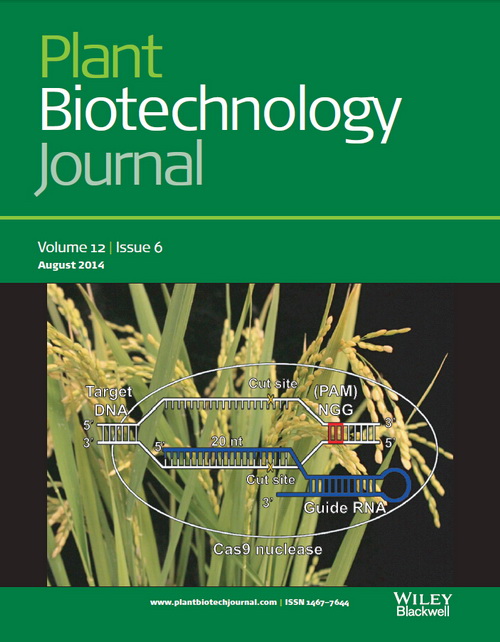我国学者利用CRISPR/Cas9系统实现水稻特定基因的新定点突变

CRISPR (clustered regularly interspersed short palindromic repeats)/Cas是源于细菌及古细菌中的一种后天免疫系统,它可利用靶位点特异性的RNA指导Cas蛋白对靶位点序列进行修饰。自2013年以来,CRISPR/Cas系统已经成功应用于人类、小鼠、斑马鱼、家蚕、果蝇、酵母、拟南芥及水稻等多个物种中。
上海植物逆境生物学研究中心(PSC)首席科学家,美国科学院院士朱健康研究员带领团队,已经利用CRISPR/Cas系统成功实现了对模式植物拟南芥和农作物水稻中特定基因的定点突变(Miao et al., 2013, molecular Plant; Feng et al., 2013,Cell Research),并进一步在拟南芥中研究了CRISPR/Cas诱导的基因突变或基因校正的模式、效率、特异性及遗传度等(Feng et al., 2014,PNAS)。但对于CRISPR/Cas系统在水稻中产生突变的特点、效率、遗传性及特异性等目前还不清楚。
朱健康研究员领导研究小组进一步测试了2个水稻亚种(粳稻日本晴和籼稻Kasalath)11个靶基因中CRISPR/Cas9诱导产生突变的效率、特点、遗传性及特异性等。
对T0代转基因植株的检测表明,CRISPR/Cas9系统在所有11个靶基因位点都诱导产生了突变,突变效率高达66.7%,且超过一半(6/11)的靶基因位点在T0代获得纯合突变体。同时研究表明,CRISPR/Cas9诱导产生的基因突变在后代的遗传传递符合经典的孟德尔定律。对CRISPR/Cas9系统产生的突变类型分析表明,单碱基的突变类型超过70%,且大部分(53.9%)为单碱基的插入;超过10个碱基的突变类型仅为3.7%。通过全基因组重测序及检测与靶序列高度同源的序列,研究小组仅在只有一个碱基不同的潜在脱靶位点检测到突变,这表明CRISPR/Cas9系统在水稻中有很高的特异性。
该研究表明CRISPR/Cas9系统可实现对水稻特定基因的高效、可稳定遗传的及特异性的定点突变。这项研究成果为CRISPR/Cas9系统在水稻中的稳定应用及进一步应用该技术提高水稻的产量、抗性及品质等提供了理论基础。
该研究于2014年5月23日在线发表于国际学术期刊Plant Biotechnology Journal杂志上,7月17日被选为该杂志第12卷第6期的封面文章。该项研究得到了中国科学院的资助。
原文摘要:
Hui Zhang, Jinshan Zhang, Pengliang Wei,Botao Zhang, Feng Gou, Zhengyan Feng,Yanfei Mao, Lan Yang, Heng Zhang, Nanfei Xu andJian-Kang Zhu
The CRISPR/Cas9 system has been demonstrated to efficiently induce targeted gene editing in a variety of organisms including plants. Recent work showed that CRISPR/Cas9-induced gene mutations in Arabidopsis were mostly somatic mutations in the early generation, although some mutations could be stably inherited in later generations. However, it remains unclear whether this system will work similarly in crops such as rice. In this study, we tested in two rice subspecies 11 target genes for their amenability to CRISPR/Cas9-induced editing and determined the patterns, specificity and heritability of the gene modifications. Analysis of the genotypes and frequency of edited genes in the first generation of transformed plants (T0) showed that the CRISPR/Cas9 system was highly efficient in rice, with target genes edited in nearly half of the transformed embryogenic cells before their first cell division. Homozygotes of edited target genes were readily found in T0 plants. The gene mutations were passed to the next generation (T1) following classic Mendelian law, without any detectable new mutation or reversion. Even with extensive searches including whole genome resequencing, we could not find any evidence of large-scale off-targeting in rice for any of the many targets tested in this study. By specifically sequencing the putative off-target sites of a large number of T0 plants, low-frequency mutations were found in only one off-target site where the sequence had 1-bp difference from the intended target. Overall, the data in this study point to the CRISPR/Cas9 system being a powerful tool in crop genome engineering.
作者:中科院

